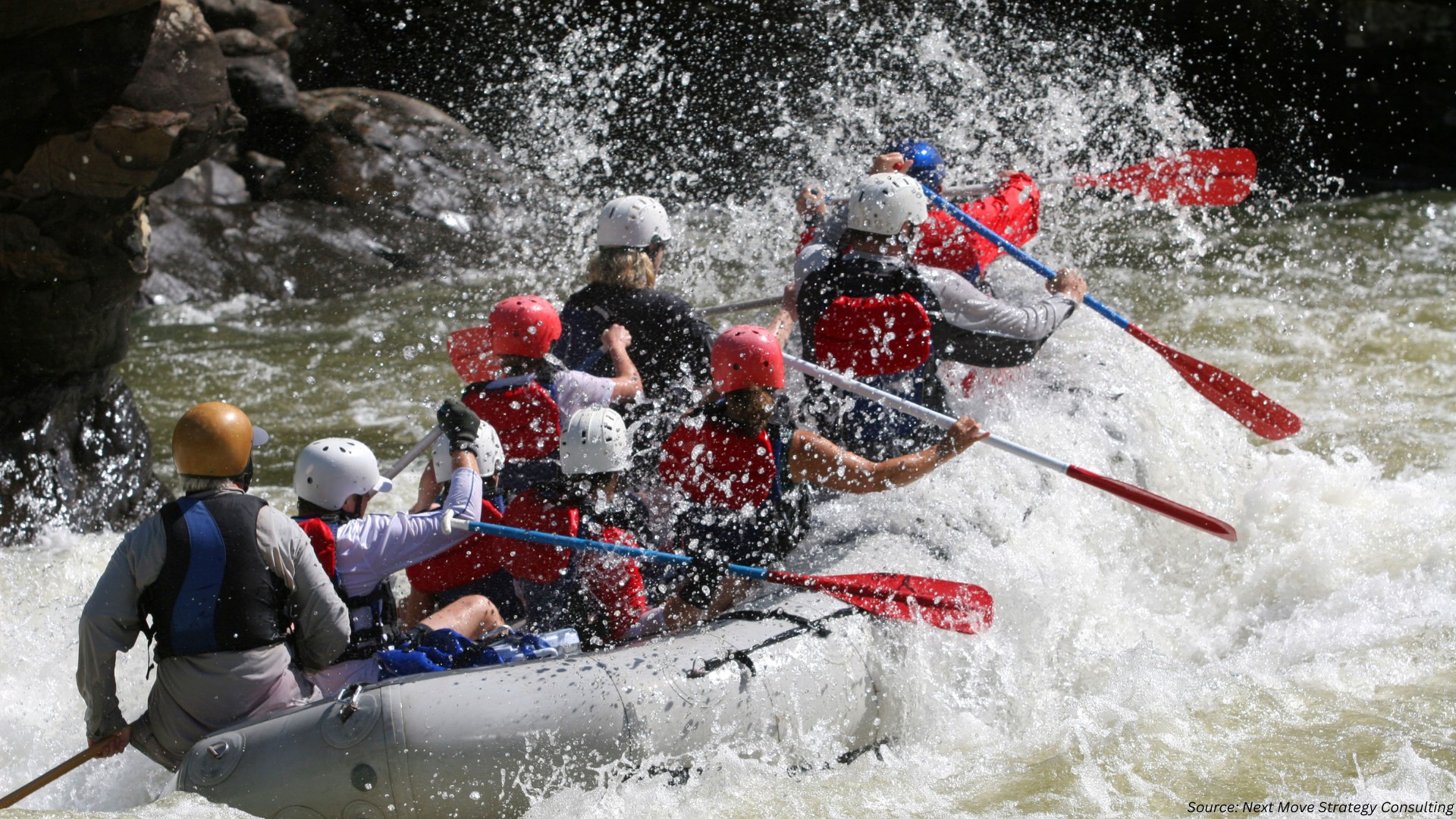Why Is Adventure Tourism Booming in 2025: Trends, Safety, and Eco-Innovation
Published: 2025-09-19

Adventure tourism is capturing the imagination of travelers worldwide, blending thrill, culture, and sustainability. From river rafting in India’s rugged Arunachal Pradesh to eco-tourism initiatives in Kuwait, this sector is evolving rapidly.
But what makes adventure tourism so appealing in 2025, and how are destinations leveraging it to attract visitors? This blog explores the latest trends, safety measures, and opportunities in the adventure tourism.
What Are the Key Trends Driving Adventure Tourism in 2025?
The global Adventure Tourism Market size is expected an elevation of USD 2824.41 billion by 2030 witnessing a CAGR of 28.8%.
Adventure tourism is thriving due to a growing demand for unique, immersive experiences that combine physical challenges with cultural and environmental engagement. Destinations are tapping into this trend by offering diverse activities like river rafting, trekking, and eco-friendly adventures.
-
Eco-Tourism Integration: Places like Arunachal Pradesh are promoting eco-tourism through events like the Siang River rafting expedition, which showcases sustainable travel while highlighting local biodiversity.
-
Cultural Immersion: Jammu’s tourism strategy emphasizes adventure alongside cultural heritage, with initiatives like the Jammu river rafting festival blending folk traditions with outdoor activities.
-
Technology-Driven Promotion: Ladakh is leveraging Bollywood and social media influencers to boost tourism, showcasing adventure activities like trekking and biking to a global audience.
-
Digital Accessibility: Kuwait’s “Visit Kuwait” portal, launched in 2025, simplifies access to adventure and cultural tourism through an all-in-one digital hub for e-visas and travel planning.
The adventure tourism market is growing due to its focus on sustainability, cultural integration, and digital innovation. Destinations are combining thrilling activities with eco-conscious and tech-savvy approaches to attract modern travelers.
Who Are the Key Players Shaping the Adventure Tourism Market?
The adventure tourism market is highly competitive, with key players like G Adventures, Intrepid, Expedia, Aquaterra Adventures India Pvt Ltd., and others driving growth through past achievements, current trends, and future innovations.
How Are Safety Guidelines Shaping Adventure Tourism?
Safety is a cornerstone of adventure tourism, ensuring travelers can enjoy high-adrenaline activities with confidence. In 2025, governments are introducing robust guidelines to standardize safety across adventure sports.
-
India’s New Safety Standards: The Indian Ministry of Tourism has introduced guidelines for growing adventure segment. These guidelines for States and UTs support tourism via schemes like Swadesh Darshan and PRASHAD. The upgraded Incredible India Digital Platform uses AI for real-time updates and bookings. NIDHI+ integrates with IIDP to provide service provider data—collectively enhancing India’s tourism experience.
-
Local Implementation: In Arunachal Pradesh, safety measures were prioritized during the Siang River rafting expedition, with ensured participant safety. The participants were trained in basic rafting techniques and safety measures, contributing to their skill development in adventure sports.
Safety guidelines are enhancing trust in adventure tourism by enforcing certifications, risk management, and professional training, making activities like rafting and trekking safer for all.
Where Are the Emerging Adventure Tourism Hotspots?
New destinations are emerging as adventure tourism hubs, offering unique landscapes and activities. India and the Middle East are leading the charge with innovative projects.
|
Destination |
Key Activities |
Unique Features |
|
Arunachal Pradesh, India |
River rafting, trekking |
Siang River expedition, eco-tourism focus |
|
Jammu, India |
Trekking, rafting, paragliding |
Cultural festivals |
|
Ladakh, India |
Biking, trekking, mountaineering |
Bollywood and influencer promotions |
|
Kuwait |
Desert adventures, cultural tours |
“Visit Kuwait” digital portal |
|
Andhra Pradesh, India |
Eco-adventures, island exploration |
Irakam Island eco-tourism development |
Emerging hotspots like Arunachal Pradesh, Jammu, Ladakh, Kuwait, and Andhra Pradesh are diversifying adventure tourism with unique activities and sustainable initiatives, drawing global travelers.
Why Is Eco-Tourism a Game-Changer for Adventure Travel?
Eco-tourism is redefining adventure travel by combining thrill with environmental responsibility. Destinations are prioritizing sustainability to attract conscious travelers.
-
Arunachal Pradesh’s Model: The Siang River rafting expedition promotes eco-tourism by highlighting the region’s biodiversity and encouraging sustainable practices among tourists.
-
Andhra Pradesh’s Island Project: Irakam Island is being developed as an eco-tourism spot, offering activities like birdwatching while preserving natural habitats.
-
Jammu’s Sustainable Approach: Jammu integrates eco-tourism with adventure, promoting activities like trekking in eco-sensitive zones to balance tourism and conservation.
Eco-tourism is transforming adventure travel by emphasizing sustainability, making destinations like Arunachal Pradesh and Andhra Pradesh leaders in responsible tourism.
What Challenges Does Adventure Tourism Face in 2025?
Despite its growth, adventure tourism faces challenges that could hinder its potential. Addressing these is crucial for sustained success.
-
Safety Compliance: While India’s new guidelines are a step forward, enforcing them across remote areas like Ladakh remains challenging due to limited infrastructure.
-
Environmental Impact: High tourist footfall in eco-sensitive areas like Arunachal Pradesh risks environmental degradation if not managed properly.
-
Accessibility: Kuwait’s digital portal improves access, but language barriers and digital literacy gaps may limit its reach for some travelers.
Adventure tourism must overcome challenges like safety enforcement, environmental risks, and accessibility to maintain its growth trajectory.
Next Steps for Adventure Tourism Enthusiasts
Ready to dive into the adventure tourism boom? Here are actionable steps to get started:
-
Research Destinations: Explore emerging hotspots like Arunachal Pradesh or Kuwait using credible sources like the “Visit Kuwait” portal or local tourism boards.
-
Prioritize Safety: Choose operators certified under new safety guidelines, especially for high-risk activities like rafting or paragliding.
-
Support Eco-Tourism: Opt for sustainable activities like eco-tours on Irakam Island or cultural festivals in Jammu to minimize your environmental impact.
-
Leverage Technology: Use digital platforms like Kuwait’s tourism portal for seamless trip planning and e-visa applications.
Stay Informed: Follow updates from tourism ministries and local news to discover new adventure opportunities and safety protocols.
Final Thoughts:
Adventure tourism in 2025 is a dynamic blend of thrill, culture, and sustainability. By embracing safety standards, eco-conscious practices, and digital tools, travelers and destinations can unlock its full potential. Start planning your next adventure today!
About the Author
 Sneha Chakraborty is a seasoned SEO Executive and Content Writer with over 4 years of experience in the digital marketing space, bringing a strong command of online visibility strategies and a keen insight into the evolving digital landscape. She specializes in enhancing online visibility and user engagement through data-driven strategies and creative content solutions. Sneha is passionate about translating complex digital concepts into accessible content for a wide audience. Outside of work, she enjoys reading, sketching, and exploring the outdoors through nature photography.
Sneha Chakraborty is a seasoned SEO Executive and Content Writer with over 4 years of experience in the digital marketing space, bringing a strong command of online visibility strategies and a keen insight into the evolving digital landscape. She specializes in enhancing online visibility and user engagement through data-driven strategies and creative content solutions. Sneha is passionate about translating complex digital concepts into accessible content for a wide audience. Outside of work, she enjoys reading, sketching, and exploring the outdoors through nature photography.
About the Reviewer
 Sanyukta Deb is a skilled Content Writer and Digital Marketing Team Leader, specializing in online visibility strategies and data-driven campaigns. She excels at creating audience-focused content that boosts brand presence and engagement, while also pursuing creative projects and design interests.
Sanyukta Deb is a skilled Content Writer and Digital Marketing Team Leader, specializing in online visibility strategies and data-driven campaigns. She excels at creating audience-focused content that boosts brand presence and engagement, while also pursuing creative projects and design interests.




















Add Comment